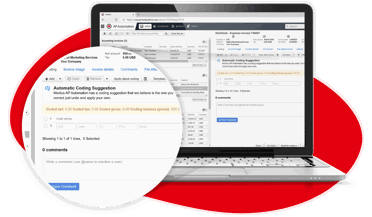Navigating Tariffs, Inflation & Cost of Goods Sold
How CFOs can leverage AP for bottom-line growth
- Introduction
- Why CFOs should shift focus to AP
- How AP can improve cash flow & profitability
- Visibility into costs: a CFO’s strategic advantage
- Smarter cash flow management
- Top 3 challenges within B2B payments
- Reducing operational costs
- Strengthening supplier relationships
- The cost of poor AP management
- Leveraging technology for AP optimization
Publisher’s statement: This blog is an adaptation of an original editorial written by Dean Baxter, Enterprise Sales Executive at Medius, based on his experience and expertise working with financial decision-makers for over 25 years. Read the original editorial here.
As we move deeper into 2025, CFOs face increasing pressure from rising tariffs, inflation, and supply chain disruptions. These challenges are squeezing profit margins and making financial planning more complex.
Does this sound familiar?
![]()
"Too many times, when I meet with CFOs, the focus is on revenue growth. But now, the impact of tariffs on revenue and the trickle-down effect on consumers is taking center stage."
— Dean Baxter, Sales Executive, Medius
While revenue growth is key to profitability, long-term success also depends on controlling costs and maintaining healthy cash flow. So, what happens if revenue slows? How can you still protect margins?
A very effective—yet often overlooked—strategy in cost control lies in optimizing Accounts Payable (AP) operations.
Why CFOs should shift focus to AP
Visibility into the cost of operations comes down to two key areas:
Cost of Goods Sold (COGS)
The direct cost of producing goods or services.
Operational efficiency
How well internal processes and employee expenses support financial health.
Many companies look for quick cost-cutting solutions like layoffs. But these short-term fixes can hurt productivity morale and even increase rehiring costs. Instead, look internally at processes that boost cash flow and give you key insights into COGS, helping to counter the effects of rising tariffs.
When handled strategically, AP can directly impact your bottom line by optimizing payments, strengthening supplier relationships, and keeping overall costs in check. Autonomous AP automation provides a smarter, more strategic way to manage costs without sacrificing workforce stability.

How AP can improve cash flow & profitability
Visibility into costs: a CFO’s strategic advantage
An efficient, automated AP process gives CFOs real-time insights into COGS and operational expenses. With better transparency into invoices, payment terms, and supplier obligations, you can:
- Make informed payment decisions.
- Optimize cash flow timing.
- Reduce financial waste.
With complete visibility into your AP data, you gain control over spending and unlock opportunities for cost savings.
Just look at invoice processing costs – automation helps you slash costs by as much as 80% percent by automating AP processes, as shown in our Medius AP Benchmark Report.
“Medius AP Automation enabled us to reach high automation rates right from the start. And we proactively work on continuous improvements. We now have better visibility into the process to understand where things go wrong and where we need to improve.”
Pim Beijen
Group NWC Manager, SoftwareONE
Smarter cash flow management
A well-managed AP process can also help CFOs optimize cash flow while maintaining strong supplier relationships. Key strategies include:
-
Extending Days Payable Outstanding (DPO):
Holding onto cash during financial strain, like rising inflation or tariffs, offers short-term flexibility.
-
Early Payment Discounts:
On the flip side, paying early can lead to discounts that lower COGS.
Balancing these approaches ensures financial stability without jeopardizing supplier goodwill.
Top 3 challenges within B2B payments
Long payment approval times
41% of B2B payment teams in 2024 cite lengthy approval times as their top challenge, delaying payments and risking late fees.
Payment fraud risk
34% of businesses experienced a payment fraud attack last year, highlighting the need for strong prevention technology.
Lack of visibility into payment data
22% of AP teams struggle with limited visibility into payment activity, impacting decision-making and efficiency.
Download the Ardent Partners report to learn how to tackle these challenges.
Reducing operational costs
Manual AP processes are costly—not just in terms of staffing but also in inefficiencies like late payments and invoice errors. But when you automate, you can drive cost savings and efficiencies that impact the bottom line, including:
-
Process invoices faster with fewer errors.
The cost of manually processing a single invoice can range from $12 to $30–but automation can reduce this cost to as little as $3 per invoice.
-
Reduce the need for large AP teams.
-
Catch costly fraud before it happens.
-
Allow finance teams to focus on strategic initiatives.
Instead of chasing down approvals, employees can focus on high-value tasks like forecasting and supplier negotiations.
Proof: During a webinar with SSON, we asked attendees about the main perk of adopting an autonomous AP process. The audience agreed that the key benefit is freeing time for strategic initiatives.
What benefit of autonomous invoice processing is the biggest driver to change for your organization?
Time saved to focus on more strategic initiatives (55%)
Cost savings and/or headcount reduction (18%)
Improved data management and analytics (16%)
Better fraud and risk management (11%)
Better compliance (0%)
Strengthening supplier relationships
Tariffs and inflation put added pressure on supplier relationships, making strong partnerships more crucial than ever. With the right AP automation, you can:
- Ensure timely, accurate payments.
- Avoid disputes over invoicing errors.
- Negotiate better terms with trusted suppliers.
Nearly half of supplier payments are delayed, even though 80% of suppliers offer discounts for early payments. By streamlining AP, companies can cut processing time from six days to one—unlocking early payment discounts, securing priority inventory, and improving credit terms. These advantages drive long-term cost savings and enhance financial stability.
The cost of poor AP management
Ignoring a critical process like AP management can have unexpected consequences, hidden costs, hurt profit margins, and lead to:
Late payment fees and penalties
Missing deadlines leads to unnecessary expenses.
Missed discounts
Lost opportunities to reduce COGS.
Supplier strain
Damaged relationships can impact supply chain stability.
Today’s economic conditions demand financial agility. For CFOs, this means looking beyond revenue and focusing on cost control, cash flow optimization, and supplier relationships. A well-managed AP function isn’t just a cost center—it’s a strategic advantage. Automating and optimizing AP will improve COGS management, strengthen financial resilience, and position your business for long-term growth.
Leveraging technology for AP optimization
This is where solutions like Medius come in. We understand your challenges and can help you achieve process autonomy, bottom-line savings, and internal efficiencies. We’ll help you transform AP from an operational function into a bottom-line growth driver.
Let’s explore how to help you save.
Find out how much you can save.
Global trends in accounts payable: what to watch in 2025









